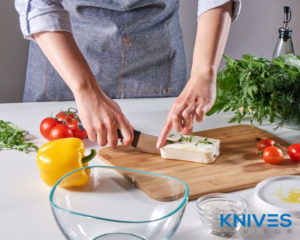
For both professional chefs and for enthusiastic home cooks, it is important to get the right kitchen equipment. For both professionals and keen amateurs, Japanese knives are a popular choice.
If you choose these types of knives, then it is essential that you buy the right cutting board to use alongside your knife to prevent damage and work efficiently. Here are some things to consider when buying the best cutting boards for Japanese knives, as well as reviews of some of the top options available.
10 Cutting Boards To Take Care Of Your Japanese Knives
There are many cutting boards available and the following are some of the best cutting boards intended to use with Japanese knives.
1. Kiso Hinoki Cutting Boards
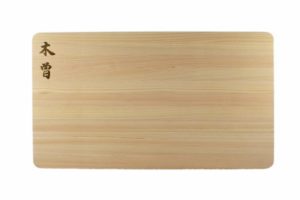
These large Japanese wooden cutting boards measure 20-inches by 12-inches and are one-inch deep, which gives good protection to your work surface and ample space for food preparation. They are made from 100% Japanese cypress, which is a superior soft wood that is known for being gentle on Japanese knives.
This is a renewable wood that is sourced from Kiso and the surrounding area. The boards are made from one-inch thick strips of wood and are not layered from thin strips. A further benefit of this board is that it resists the growth of mold and bacteria because it is rich in natural phytoncide compounds.
This is a smart-looking board that has Japanese symbols printed onto the top left corner of the board.
Key Features:
- Smart appearance
- Safe for Japanese knives
- Soft Cypress wood
- Antibacterial and mold-resistant
- Large surface area
2. Yoshihiro Professional Grade Cutting Board
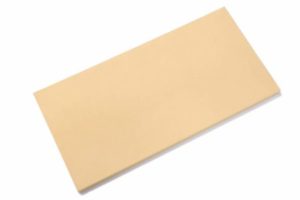
When it comes to the best cutting boards for Japanese knives, the Yoshihiro is one to strongly consider.
This Hi-soft cutting board is constructed from a specially designed synthetic material. This is constructed to reduce the impact on the blade to reduce the risk of damage, increase your knife’s lifespan, and retain the edge for longer.
It also minimizes the stress on your hand will preparing food. It is easy to clean and resistant to both bacteria and odors. The extra-large board measures 23.6-inches long, 11.8-inches wide, and 0.8 inches deep. This is a good size to give you plenty of room for food preparation.
However, this board is available in a range of other sizes, including small, medium, large, XX-large, and XXX-large.
Key Features:
- Size options
- Synthetic materials
- Reduce impact on the knife and your hand
- Resistant to odors and bacteria
3. Shun DM0817 Hinoki Cutting Board
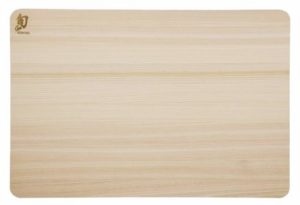
Despite being manufactured by one of the leading Japanese knife brands, this cutting board is one of the most affordable options. It is a good quality board that is made from Japanese cypress.
This wood is medium soft, so it is durable yet soft enough to reduce the impact on the blades. In turn, this reduces the likelihood of you damaging your knives while chopping and slicing. The wood used is grown in Japan and is certified for sustainable forest management practices by the Forest Steward Council (FSC) of Japan.
These cutting boards are easy to care for as you just need to wipe them with a damp cloth and a mild detergent before drying with a towel. They are also stain and bacteria-resistant.
Key Features:
- Reputable brand
- Affordable
- Stain and bacteria-resistant
- Renewable cypress wood
- Reduces impact and damage
4. Natural Earth Kitchen Hinoki Cutting Board

A stunning yet practical kitchen accessory, this cutting board differs from most others as it is a teardrop shape rather than oval. One of the benefits of this is it will fit neatly in the corner and is space-saving, which is ideal for those who have limited space available in their kitchen.
It is 20-inches long at its longest point and 10-inches wide, which is an ample surface area for food preparation. As it is one-inch thick, there is very little chance of your knives damaging your work surface. The board is made from authentic Japanese cypress, which is one of the materials that are least likely to damage your Japanese knives.
This lightweight cutting board has underside pads to improve grip on the work surface and this increases safety. It is easy to clean, safe to use, and resistant to mold and bacteria.
Key Features:
- Unique design
- Underside pads
- Japanese cypress board
- Mold and bacteria-resistant
- Safe for Japanese knives
5. Natural Kihinoki Cutting Board
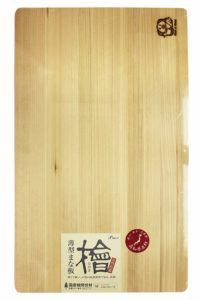
For those on a budget, this is the best cutting board for Japanese knives as it costs under $50. A lightweight option, this cutting board measures 15.5 inches by 9.45 inches and is just over half an inch deep.
Therefore, it is a good choice for those who have limited work surface space available but want a good quality cutting board for Japanese knives. It is made from Japanese cypress wood, so it will not damage your Japanese knives as the soft to medium wood reduces the amount of impact on your blades and hands. This material is also easy to clean and is resistant to mold and bacteria.
Key Features:
- Compact and lightweight
- Japanese cypress wood
- Mold and bacteria-resistant
- Reduces impact
6. Kodai Hinoki Japanese Cypress Wood Cutting Board
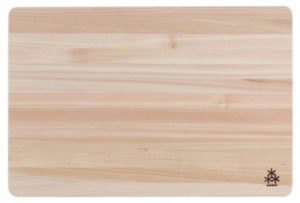
If the weight of a cutting board is an important factor for you, then this is a cutting board worth considering. At just 1.2 pounds and 0.4-inches thick, this is a lightweight and ultra-thin option. It is made from Japanese Hinoki soft wood that is gentle on your knives, so damaging your Japanese knives while using this board is unlikely.
This wood also heals itself of grooves and scars and is resistant to bacteria. Furthermore, this cutting board is stain-resistant, so it will continue to look good in the long-term. At under $50, this is a good option for those on a budget.
Key Features:
- Low cost
- Ultrathin and lightweight
- Self-healing and antimicrobial
- Reduces impact on your knives
7. Asahigomu Synthetic Rubber Cutting Board
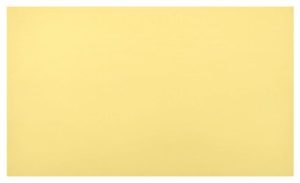
This cutting board is made from elastomer, which is a synthetic rubber material. This reduces the impact when the knife blade touches the board, thus protecting the knife edge and reducing the potential for chipping or cracking.
At just over three pounds, this is one of the heavier chopping boards available, However, the weight is an advantage if you want a sturdy and durable board that will not slide around your work surfaces. One of the greatest advantages to choosing this cutting board over others is its good heat-resistance as it is heat-resistant to between 30-degrees and 100-degrees Fahrenheit.
It is also easy to clean and bacteria-resistant.
Key Features:
- Heat-resistance
- Synthetic materials
- Durable and sturdy
- Reduces impact
- Easy to clean
8. Yoshihiro Hinoki Cypress Wood Cutting Board
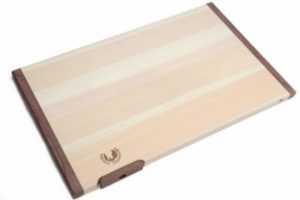
Visually, this is one of the most attractive cutting boards for Japanese knives and it has many features that also make it a good practical option. The main section of the knife is made from Hinoki cypress wood, which will reduce the impact on your knife, retain the edge, and give your knife a longer lifespan.
It is also a durable material that is easy to clean and bacteria-resistant. The side edges of the board are trimmed with walnut wood, which is a harder wood that prevents the board from warping over time.
An interesting feature of this cutting board is the inbuilt stand on the bottom edge of the board. This pulls out if you want to stand the board for storage or while cleaning underneath.
Key Features:
- Inbuilt stand
- Walnut trim to prevent warping
- Cypress wood board
- Bacteria-resistant
9. Miyabi 34535-300 Chopping Board
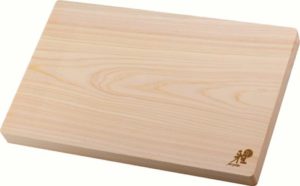
Measuring 15.74-inches by 10-inches, this cutting board is a good size for preparing food. It is made from a Japanese cypress Hinoki wood which has the right density to protect your Japanese knives.
This durable and sturdy wood reduces the impact on the blade and this reduces the likelihood of chips or cracks. It also retains the edges and gives your knives a longer lifespan. Hinoki wood is also easy to clean and it is naturally resistant to mold and bacteria.
It is an attractive looking board that is stamped with the brand logo in the bottom right corner. The corners of this rectangular board are slightly rounded, so there are no sharp edges.
Key Features:
- Durable
- Mold and bacteria resistant
- Reduces impact on your blades
- Rounded corners
10.Yamako Hinoki Wooden Cutting Board

Wrapping up our review of the best cutting boards for Japanese knives is the Yamako Hinoki.
Made in Japan, this cutting board is constructed from authentic Hinoki Japanese cypress wood. Therefore, it is unlikely that these boards will damage your Japanese knives. By reducing the impact on the blades, they will retain the edge and prevent chipping or cracking.
These cutting boards measure 19.2-inches by 10-inches and are 1.2-inches deep. They differ somewhat from many other cutting boards that you would use with your Japanese knives as they have cylindrical ends. This is so the cutting board does not touch the work surface and keeps it clean.
It also means you can easily reverse it during food preparation without transferring bacteria from one surface to another.
Key Features:
- Reversible with cylindrical ends
- Cypress wood cutting board
- Easy to clean
Things to Consider When Buying a Cutting Board
To avoid damage to your Japanese knives and to work efficiently, it is important to consider the different features of a cutting board before making your decision. Here are just some of the factors you may wish to consider when buying a cutting board to use with your Japanese knives.
Materials
The most important factor to consider when buying a chopping board is the material. There are chopping boards available in many different materials, and each has its pros and cons. Here are some of the materials from which cutting boards are made.
- Wood- These are the best cutting boards for Japanese knives. The two main types of wooden board are end grain wood and edge grain wood. End grain wood chopping boards have wood grains running up and down, while the edge grain wood boards are simply strips of wood layered together. End grain wood boards are usually the best choice. These cause the least damage to your knives and prolong their lifespan, but are also the most expensive option. One other downside to wooden cutting boards is that they are more high maintenance, as they need oiling, and you cannot put them in the dishwasher.
- Bamboo- Often, people mistake bamboo as a type of wood and think that it is a good option for protecting your knives. However, this is not the case as bamboo is a type of grass and it will harm your knife blades. This is not only because of the bamboo, but also because the boards are formed by shredding the bamboo and forming it into a board with glue that becomes very hard when set. The plus point of choosing one of these bamboo cutting boards is that they’re made from sustainable and eco-friendly material.
- Glass- Often, people will opt for a glass cutting board because they are usually the cheapest choice and they are easy to clean and maintain. However, they are the worst choice for using with Japanese knives as this hard material is likely to cause chips.
- Plastic- There are many different types of plastics used for chopping boards, so there are variations in the pros and cons of each. As a rule, plastic is a good alternative to wood for those who have a limited budget as they are cheaper and don’t damage knives as much as glass or stone. On the downside, they are not aesthetically pleasing items.
- Rubber- This has many of the same benefits as a plastic board as they are easy to clean and will cause little damage to knife edges. They are a little heavier than plastic boards and usually cost more.
- Stone- A cutting board made from stone is durable and aesthetically pleasing. They can come in useful in the kitchen but are best saved for tasks such as pastry work. They are a poor option for using with Japanese knives as stone is a hard material that will damage your knives.
Aesthetics
For many people, the style and appearance of the cutting board is an important element when choosing this kitchen accessory. Think about the following:
- You might prefer a style of cutting board that coordinates with other aspects of your kitchen or accessories.
- Style can impact on the price of a chopping board.
- By concentrating more on style than practical aspects of your cutting board, you may forfeit the suitability of the cutting board to use with Japanese knives.
Size
The size of the board is important for several reasons, so you should consider the following points:
- A larger chopping board will give you more usable work surface which is good for preparing larger or multiple ingredients.
- If you only have a small kitchen, then choosing a smaller chopping board is logical.
- The price of a chopping board depends on its size.
- The depth is a factor in the size of a cutting board. A deeper cutting board is better as it offers more protection to your kitchen work surfaces as knives are less likely to come into contact with the surface.
Maintenance
In many cases, people prefer to buy items that need as little care as possible. However, it is often worth buying something that needs a little more care.
- A glass or stone cutting board will need the least care as you can simply wipe this with a little disinfectant and a damp cloth. However, they will damage your Japanese knives, and this will cause more problems in the long run.
- Wooden chopping boards need a little more care, but they are worth the effort as they are less likely to damage your knives.
Price
Regardless of what a person is buying, the price is often one of the most relevant considerations. The following points are relevant to the price of the cutting board:
- Factors that impact on the price of a cutting board include the material, the size, the brand, and the style.
- If a cutting board is less likely to damage your knives, then it is worth paying a little more. This makes sense as you are less likely to need to replace your expensive Japanese knives.
Why Do Japanese Knives Need Special Care?
You may wonder why your choice of cutting board is so important if you use Japanese knives. This is because Japanese knives need special care compared to other types of knives.
Japanese knives (Nakiri, Gyuto, Yanagiba etc.) are generally made from high carbon steel. This is a hard and brittle material that has very little flexibility. Therefore, these knives are prone to chipping and cracking. Similarly, they are usually very thin and sharpened with a lower angle than Western knives, so they have a very fine edge that is prone to damage.
Therefore, you need to take special care of these knives to avoid damage. Your choice of cutting board will impact on your knife blades and making the wrong choice will cause dull knives with chips and cracks. The right cutting board will help you to retain the edge and prevent cracking or chipping. The overall best option to maintain your knives is to use a wooden chopping board.
Final Verdict
If you need a cutting boards to use alongside your Japanese knives, then you will find a vast choice of products available. The best cutting board for Japanese knives is, in our opinion, the Kiso Hinoki Cutting Board. This is a smart-looking chopping board that is made from a good quality wood that reduces impact and protects your knives. It is also easy to clean and is resistant to mold, bacteria, and stains.
If you have a limited budget and do not want to spend a lot of money, then one great option is the Hinoki Japanese Cypress Wood Cutting Board. Although it is a lightweight and ultra-thin chopping board, it still reduces the impact on your knives. It is a self-healing board that is stain and bacteria-resistant.
Curious about glass cutting board? Read about the pros and cons of glass cutting boards here.
![10 Best Cutting Boards for Japanese Knives [2025]](https://knivesadvisor.com/wp-content/uploads/2019/01/Best-Cutting-Board-for-Japanese-Knives.jpg)